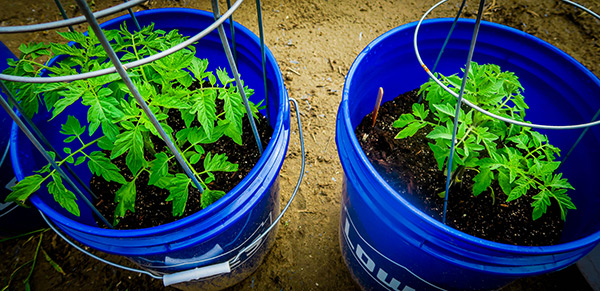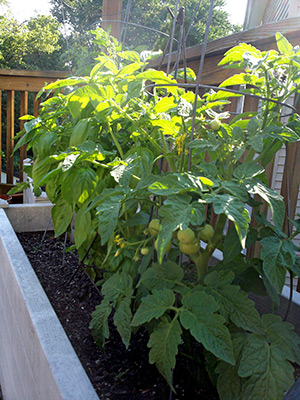Tomato Talk
A Full Season of Tomato-Growing Information

Got bad soil? Buckets, troughs, and pots all work well for growing tomatoes, too.
Growing tomatoes in containers
Small space, poor soil? Container gardening may be the answer.
If your garden is small or has heavy clay soil that would make nice pottery, don’t fret. You can grow tomato plants in pots and have a bumper crop of red, juicy orbs this summer. Tomatoes are warm-loving plants that need six to eight hours of sunlight. If you have a spot like that on a balcony, deck, patio, a side yard or along a fence or wall, you’re good to grow. And, if you have the luxury of a big garden, pop a few pots of tomatoes into a sunny perennial border for some vertical (and edible) focal points.
By the end of summer, a healthy tomato plant will have produced a large mass of roots, so any pot that you choose should be at least 24 inches tall and wide—or it should hold 15 gallons or more of potting mix. Bigger is always better. Small pots heat up quickly in hot weather, which makes the soil dry out fast and can stress the plant.
Garden centers offer plenty of elegant planters made from plastic, composite resin, terra cotta, concrete, and ceramic materials. But you can also use colorful, inexpensive plastic “tubs” with handles that are sold in big box stores. The tubs typically hold 10 or 17 gallons. Drill a few holes in the bottom and around the side for drainage. Containers need drainage holes; otherwise, waterlogged roots will rot.
Hold 'em up
If you’re planting an indeterminate type tomato, you’ll need a long stake or a tall tomato cage for support. You can get by with a short stake or a smaller cage for a determinate type plant. To get started, place a few coffee filters over the drainage holes to keep the soil from washing out. Next, add moistened organic, soilless potting mix to within an inch of the pot’s rim. It’s often easier to open the bag and pour a little water into the mix to wet it. Don’t use heavy topsoil because it holds too much water. Place the stake or a tall tomato cage in the pot. Now you’re ready to plant.

Water your tomato transplant and gently remove it from the pot it came in. If the plant is tall and spindly, carefully pinch off a few of the bottom leaves. Bury it right up to the remaining leaves. The plant will grow new roots under the soil along the leggy stem, resulting in a sturdier plant. Because soilless potting mix dries out quickly, help conserve moisture by placing a thin layer of compost on top of the mix. (Compost is sold in bags at garden centers.)
By midsummer, you may find that your containers need watering once or sometimes twice a day in hot weather. Poke your finger into the soil. If it feels dry to a depth of 2 inches, it’s time to water. When the temperatures hover in the 90s and the sun is overhead, some leaves may wilt even if the soil is moist. No worries—it’s the plant’s way of conserving moisture.
Feeding
The soilless potting mix you choose may contain slow-release fertilizer. But it’s a good idea to fertilize the plants every two to three weeks, especially when they begin to flower. Frequent watering of containers causes nutrients to wash out the bottom more quickly. Tomato expert Craig LeHoullier says that foliage color is a good indication of the need for a fertilizer boost—the rich, dark green leaves start to fade if a plant needs some nutritional attention. Use an all-purpose water-soluble fertilizer. And get ready for a bumper crop.

